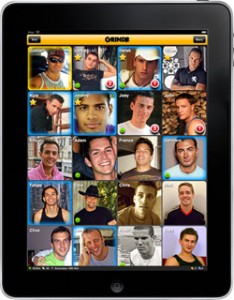Slate Magazine features Grindr ‘The Gay Bar Its new competition By June Thomas’
Slate Magazine features Grindr ‘The Gay Bar Its new competition By June Thomas’
The Gay Bar. Its new competition.
By June Thomas
The days—and nights—when gay bars had a monopoly on same-sex social lives are long gone. As much as contemporary queers may romanticize the gay bar as a sanctuary in a lonely world, most of us now have lots of safe spaces, both real and virtual, available to us.
Not convinced? Google “gay group” and the name of your town, and the search engine should cough up a range of organizations from sports leagues to book groups, gay churches to the local men’s chorus. (I swear, half the same-sex couples who make it into the New York Times‘ “Vows” section claim to have met in gay hiking groups.) Over the last three decades, a clean and sober culture has developed as an alternative to the bar scene. New York’s Lesbian, Gay, Bisexual & Transgender Community Center hosts at least 12 regular AA meetings, as well as a dozen other 12-step recovery groups, and events like NYC Queer + Sober are designed to “provide a safe and fun experience to the sober LGBT community during Gay Pride.”
When it comes to nightlife, gay revelers have more options than ever. Gay men have the circuit party scene—lavish multiday, multivenue annual events, such as the Palm Springs and Miami white parties—where the emphasis is on grand spectacle and production values that exceed anything that would be possible at a neighborhood bar. In some cities, groups use the Web to organize “guerrilla gay bars,” a sort of flaming flash mob in which homosexuals descend unannounced on a straight bar and turn it gay for one night only. And in most cities, freelance promoters produce regular “parties” at straight venues as an alternative to the “gay every day” bar scene. The trend took off in the 1980s, when the community’s desire for variety outpaced the supply of gay venues, and accelerated after 2000, when it became easier to publicize events via email.
Lesbian party promoters are especially busy: Even in the largest metropolis, lesbians rarely have more than one or two bars to choose from, so it’s natural for women to crave new vistas. Maggie Collier, of Maggie C Events, currently runs two weekly women’s parties in Manhattan. “Stiletto,” on Sundays, is a daytime event at the swank Maritime Hotel, and since it’s an outdoor bash, shorts and flip-flops are appropriate. On Wednesday nights at “Creme de la Femme,” the code is “dress to impress.” When I asked why she set that tone, she told me, “We should set the bar really high for variety. We deserve every possible option. Everything that the heterosexual nightlife community has, we ought to have those options as well.”
This sort of event is not popular with gay-bar proprietors. Former owner Elaine Romagnoli told me, “They will empty your room out. Your customers will all go to that event and come back at 3 a.m., when you have an hour to go, and they’re already trashed.” As easy as it is to understand the bar owners’ annoyance at losing their regulars to the irresistible appeal of the new and different, Collier is right when she says, “I don’t think that we should stop ourselves from giving women more options just because we respect—and I definitely do—these establishments that have been around forever and that do it every night.” And given the appealing economics, these regular parties are probably here to stay. Party promoters generally work on a commission basis, taking a percentage of the bar takings, so naturally their overhead is a fraction of the bars’.
Perhaps the gay bar’s biggest new competitors, however, are gay dating sites and apps. “Luke,” a gay man in his mid-30s, told me that new technology has been “the single most important development” in the world of gay dating. (Like some other people I interviewed for this series, he preferred not to use his real name when discussing his romantic life.) “From the time I came out in 1993 until about 1999, there was only one reliable place on a given night where you could peruse a catalog of gay men: at the bar or club. Now I have the Internet and Grindr for that.”
I first heard about Grindr from Irish writer Colm Toibin. At a fancy-pants New York panel on “Authors in the Age of the Internet” sponsored by the London Review of Books last April, then-55-year-old Toibin told a charming, shaggy-dog story about his adventures in gay social media. He described how he’d fantasized about a piece of technology that would marry a gay-dating service with GPS to create a device that would tell you “there’s a guy if you turn left.” Then he discovered that such a thing exists; it’s called Grindr. Grindr is a location-based phone app that displays a grid of photographs of other members in your immediate vicinity, arranged by distance. If you like the look of someone’s picture and blurb, you can chat and arrange to get together. I love the directness of the sample chat on the company website: “Hey bud I like your profile.” “Thanks man. You too. Where u at?” [Sends map] “Let’s meet. Here’s a photo.” Who said the art of seduction is dead?
Grindr launched in March 2009 and currently has more than 2 million users, one-half of them in the United States. Eight thousand guys sign up for the service every day. Grindr is strictly for Adams seeking Steves, but the company says that Project Amicus, an app for straight and lesbian users, will launch this summer.
Read more @ http://www.slate.com/id/2297608/


No Comments to “Slate Magazine features Grindr ‘The Gay Bar Its new competition By June Thomas’”